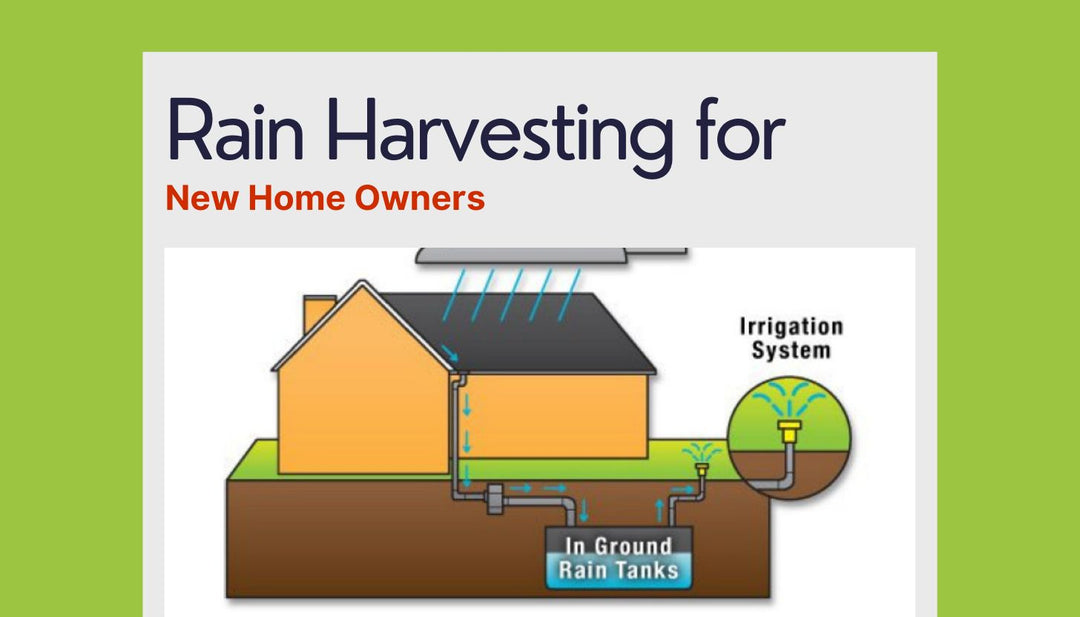Rain Water Harvesting In Maharashtra for New Home Owners

Picture this: It's a sweltering summer day in Pune. You turn on the tap, and instead of the usual trickle, you get a steady stream of crystal-clear water. No water tankers, no rationing, just pure, harvested rainwater at your fingertips. Sounds like a dream? At Ongrid, we're here to turn that dream into your reality.
Why This Matters to You
As a soon-to-be homeowner in Maharashtra, you're probably asking yourself:
- "How can I ensure a consistent water supply for my family?"
- "Is there a way to cut down on my water bills?"
- "Can my new home be both beautiful and environmentally friendly?"
If these questions resonate with you, you're in the right place. Rainwater harvesting isn't just a trendy eco-friendly option—it's a game-changer for homeowners in Maharashtra. And we at Ongrid are here to guide you every step of the way.
Your Roadmap to Water Independence

Here's how we'll navigate this journey together:
- The Big Picture: Maharashtra's Water Story
- Why is water such a hot topic in our state?
- How does rainfall vary across Maharashtra, and what does it mean for you?
- Rain Water Harvesting 101
- What exactly is rain water harvesting?
- How does it work, and why is it perfect for Maharashtra homes?
- Crunching Numbers: Your Home's Water Potential
- How much water can your roof actually collect?
- What factors affect your harvesting potential?
- Designing Your System: From Roof to Tap
- What components do you need?
- How can Ongrid integrate this seamlessly into your dream home design?
- Navigating the Red Tape
- What do Maharashtra's laws say about rainwater harvesting?
- Are there any incentives you should know about?
- The Bottom Line: Costs and Savings
- What's the initial investment?
- How much can you potentially save in the long run?
- Success Stories: Real Homes, Real Impact
- How are other Maharashtra homeowners benefiting from rain water harvesting?
- Taking the Plunge: Your Next Steps
- How can you get started with Ongrid?
- What should you consider before making a decision?
Let's Dive In: Maharashtra's Water Story

Imagine hosting a housewarming party in your new home. As your guests marvel at your beautiful interiors, you casually mention, "Oh, and all the water we're using? It's harvested right here from our roof." Impressive, right?
But before we get there, let's talk about why this matters so much in Maharashtra. Learn more about water conservation techniques.
From the rain-soaked Western Ghats to the parched lands of Marathwada, our state is a study in water contrasts. While some areas are prone to flooding during monsoons, others face severe droughts. It's a water rollercoaster that affects every homeowner.
Let's look at some eye-opening numbers:
|
Region |
Annual Rainfall (litres/sq.ft) |
What This Means for You |
|
Mumbai (Santacruz) |
185.8 |
Potential for massive water savings |
|
Pune |
58.4 |
Significant harvesting opportunity |
|
Nagpur |
88.6 |
More than enough for household needs |
|
Nashik |
53.7 |
Every drop counts |
|
Aurangabad |
60.6 |
A chance to be water-independent |
|
Ratnagiri |
237.9 |
Abundance of harvestable water |
|
Solapur |
60.0 |
Turn scarcity into sufficiency |
These aren't just numbers – they're opportunities. Whether you're building in rain-rich Mumbai or drier Solapur, there's potential to make a big difference.
The Million-Litre Question: How Much Can You Harvest?
Maharashtra Rainwater Harvesting Calculator
Now, you might be wondering, "This sounds great, but what does it mean for my home?"
Let's break it down with a simple example:
Imagine you're building a 2000 sq.ft home in Pune. Here's your potential water jackpot:
Your Water Harvest = Roof Area x Annual Rainfall and Runoff Coefficient
= 2000 sq.ft x 58.4 litres/sq.ft x 0.85
= 99,280 litres per year
That's nearly 100,000 litres of water – straight from the sky to your tap!
"But what can I do with all that water?" you ask. Great question! This harvested rainwater can be used for:
- Flushing toilets
- Watering your garden
- Washing cars and outdoor areas
- Laundry
- And with proper treatment, even for drinking!
Intrigued? You should be! In our next sections, we'll dive deeper into how you can turn your roof into a water-generating powerhouse, the nuts and bolts of designing a system, and how Ongrid can help you make it all happen seamlessly.
Rain Water Harvesting 101: Your Personal Water Factory

Remember playing in the rain as a kid? Well, it's time to channel that excitement into something revolutionary for your new home. Rain water harvesting is like having a mini water factory right on your roof. But how does it actually work?
The ABCs of Rain Water Harvesting
- Catch: Your roof becomes a giant catcher's mitt for rain.
- Clean: The water goes through a filtration process.
- Collect: Clean water is stored in tanks for future use.
Simple, right? But the impact is enormous.
"Is it really worth the effort?" you might ask. Let's put it this way: Would you ignore a gold mine in your backyard? That's essentially what you're doing if you're not harvesting rainwater in Maharashtra.
Why Rain Water Harvesting is Your New Best Friend
- Water Security: No more anxious waits for the water tanker during dry spells.
- Bill Buster: Watch your water bills shrink month after month.
- Green Glory: Reduce your environmental footprint and become the eco-hero of your neighbourhood.
- Property Perks: Boost your home's value and appeal in the real estate market.
Discover more about integrated design in green architecture
Crunching Numbers: Your Home's Water Potential
Now, let's get to the exciting part - calculating your home's water-generating superpowers!
Your Roof: The Unsung Hero
Every square foot of your roof is a potential water collector. Here's a comparison of how much water you could harvest annually based on roof size and location:
|
City |
1000 sq.ft Roof |
2000 sq.ft Roof |
3000 sq.ft Roof |
|
Mumbai |
185,800 L |
371,600 L |
557,400 L |
|
Pune |
58,400 L |
116,800 L |
175,200 L |
|
Nagpur |
88,600 L |
177,200 L |
265,800 L |
|
Nashik |
53,700 L |
107,400 L |
161,100 L |
"That's a lot of water, but what does it mean for me?" Great question! Let's break it down:
- An average family of four uses about 800 litres per day.
- In Pune, a 2000 sq.ft roof could provide 116,800 litres annually.
- That's enough to cover 40% of an average family's annual water needs!
Imagine cutting your water dependency and bills nearly in half. Sounds good, doesn't it?
Learn about passive architecture for Indian homes
Designing Your System: From Roof to Tap

Now that you're excited about the potential, let's talk about making it a reality. At Ongrid, we believe your rain water harvesting system should be as stylish as it is functional.
Components of Your Water Wonder System
- Catchment Area: Your roof, of course!
- Gutters and Downpipes: Think of these as water slides for your roof.
- First Flush Diverter: This clever device discards the initial dirty water.
- Filtration System: Ensures your water is clean and safe.
- Storage Tank: Your personal water bank.
- Pump: To get water where you need it.
"But won't all this equipment be an eyesore?" Not with Ongrid's design expertise! We integrate these components seamlessly into your home design. Imagine stylish copper gutters that enhance your façade, or an underground tank that doubles as a beautiful garden feature.
Explore our single floor elevation design with rainwater harvesting
Navigating the Red Tape: Less Boring Than You Think!
Dealing with regulations might sound as fun as watching paint dry, but in Maharashtra, it's actually pretty exciting when it comes to rain water harvesting.
The Legal Lowdown
- For new constructions over 1000 sq.m, rain water harvesting is mandatory. But why stop there? Even if your plot is smaller, you can still be a water hero!
- Many municipal corporations offer incentives for rainwater harvesting systems. It's like the government is saying, "Hey, thanks for being awesome!"
Incentives That'll Make You Smile
- Property Tax Rebates: Some cities offer up to 5-10% rebate on property tax. Ka-ching!
- Fast-Track Approvals: Get your building plans approved faster. Time is money, after all!
- Technical Support: Free expert advice from municipal corporations. It's like having a water-wise guru on speed dial.
Understand SSP compliance and building codes
The Bottom Line: Costs and Savings
Let's talk about money. After all, you're not just building a home; you're making an investment.
Initial Costs: The Smart Spender's Guide
|
Component |
Estimated Cost Range (₹) |
|
Filtration System |
15,000 - 30,000 |
|
Storage Tank (5000L) |
20,000 - 40,000 |
|
Pipework and Gutters |
10,000 - 20,000 |
|
Installation |
10,000 - 20,000 |
|
Total |
55,000 - 110,000 |
"Whoa, that's a chunk of change!" you might say. But hold on, let's look at the flip side.
The Savings Saga
Let's say you harvest 100,000 litres per year (easily doable with a 2000 sq.ft roof in most Maharashtra cities).
- Average water cost: ₹20 per 1000 litres
- Annual savings: 100 x ₹20 = ₹2,000
"Only ₹2,000? That doesn't sound like much," you might think. But remember:
- Water rates are likely to rise in the future.
- During water scarcity, prices can skyrocket. Your harvested water becomes liquid gold!
- The real value? Peace of mind knowing you have water when others don't.
Plus, the potential increase in your property value can far outweigh the initial investment.
Learn about urban heat island design
Success Stories: Real Homes, Real Impact
Let's look at some real Maharashtra homeowners who are reaping the benefits of rain water harvesting:
- The Deshmukh Family, Pune
- 3000 sq.ft home
- Harvest: 150,000 litres annually
- Result: 70% reduction in municipal water dependency
- Green Heights Apartment, Mumbai
- 50-unit complex
- Harvest: 1 million litres annually
- Result: Landscape maintenance costs cut by 80%
- The Eco Farmhouse, Nashik
- 5000 sq.ft roof
- Harvest: 200,000 litres annually
- Result: Completely self-sufficient in water, even in dry months
These aren't just success stories; they're a glimpse into what your home could achieve!
Discover 5 unique elements that define Maharashtra's home design


















